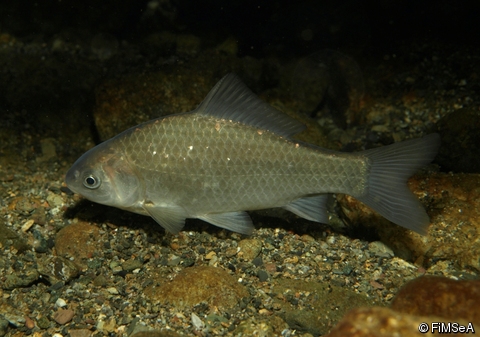| Taxon ID: 10,280 Total records: 39,143 | ||||||||||||||
Carassius auratus
Country
| Country | Singapore |
|---|---|
| Continent Ocean | Asia |
Classification
| Kingdom | Animalia (COL) |
|---|---|
| Phylum | Chordata (COL) |
| Class | Actinopterygii (COL) |
| Order | Cypriniformes (COL) |
| Family | Cyprinidae (COL) |
Taxonomy
| Genus | Carassius | Reference | |
|---|---|---|---|
| SubGenus | Vernacular Name | ||
| Species | auratus | IUCN Threat Status-Year | Least Concern, 2010 |
| SubSpecies | Nat'l Threat Status-Year | Not Evaluated, 2000 | |
| Infraspecies | Reason for Change | ||
| Infraspecies Rank | CITES | ||
| Taxonomic Group | Native Status | Introduced | |
| Scientific Name Author | Linnaeus, 1758 | Country Distribution | Singapore; |
| Citation | Huckstorf, V. & Freyhof, J. 2013. Carassius auratus. The IUCN Red List of Threatened Species 2013: e.T166083A1110472. https://dx.doi.org/10.2305/IUCN.UK.2013-1.RLTS.T166083A1110472.en. Downloaded on 01 October 2020. | Description | JUSTIFICATION The species is assessed as Least Concern as it has a large distribution area and there are no known widespread threats to this species. RANGE DESCRIPTION The species is reported to be native to East Asia: from the Amur River to the Pearl River basin including the Korean Peninsula and Taiwan (Freyhof and Kottelat 2007). It was domesticated in China more than 1,000 years ago, introduced to Japan in the 16th century and from Japan imported to Europe: Portugal 1611, England 1691 and France 1755. From then it was introduced throughout Europe and most of the world. It was introduced throughout the world as the Asian form of the goldfish. Several countries report adverse ecological impact after introduction. This is possibly the species (or Carassioides acuminatus) "Pa Fek" that has been introduced into the Nam Theun reservoir in Lao PDR where it has established very well. DESCRIPTION There is no information available on the species population within its natural distribution range. HABITAT AND ECOLOGY This species inhabits rivers, lakes, reservoirs, ponds and ditches (Man and Hodgkiss 1981, Etnier and Starnes 1993) with stagnant or slow-flowing water (Billard 1997). It occurs in eutrophic fresh and brackish waters, well vegetated ponds and canals (Kottelat and Freyhof 2007). The maximum recorded salinity is 17 ppt, but it is unable to withstand prolonged exposure above 15 ppt (Schwartz 1964). It feeds on a wide range of food including plants, small crustaceans, insects, and detritus (Kottelat and Freyhof 2007). The species usually lives up to about 20 years under artificial conditions. It is oviparous, with pelagic larvae. It spawns when water temperatures reach 15-20 °C. Juveniles require high temperature to grow. Individual females spawn with a few males in dense vegetation. The eggs are sticky, attached to water plants or other submerged objectives. THREATS No threats to this species are known. USE AND TRADE The species is valued as ornamental fish for ponds and aquaria; it is edible but rarely eaten (Frimodt 1995). It is also used as an experimental species (Robinson et al. 1991). CONSERVATION ACTIONS None required. |
| Source |
Record Level
Growth Parameters
| Temperature | 0 | Observed Weight | 0 |
|---|---|---|---|
| Sex | Previous Catalog Number | ||
| Life Stage | Relationship Type | ||
| Preparation Type | Related Catalog Item | ||
| Individual Count | 0 | GML Features | |
| Observerd Individual Count | 0 | Notes |
Collecting Event
Images
|
Additional Info
Synonyms To Manage Synonyms for Carassius auratus, click this link: Synonyms. |
Carasius auratus (Linnaeus, 1758) ¦ Carassius auratus argenteaphthalmus Nguyen, 2001 ¦ Carassius auratus auratus (Linnaeus, 1758) ¦ Carassius auratus buergeri Temminck & Schlegel, 1846 ¦ Carassius auratus burgeri Temminck & Schlegel, 1846 ¦ Carassius auratus cantonensis Tchang, 1933 ¦ Carassius auratus grandoculis Temminck & Schlegel, 1846 ¦ Carassius auratus wui Tchang, 1930 ¦ Carassius burgeri Temminck & Schlegel, 1846 ¦ Carassius carassius (non Linnaeus, 1758) ¦ Carassius carassius auratus (Linnaeus, 1758) ¦ Carassius chinensis (Gronow, 1854) ¦ Carassius coeruleus Basilewsky, 1855 ¦ Carassius discolor Basilewsky, 1855 ¦ Carassius encobia Bonaparte, 1845 ¦ Carassius grandoculis Temminck & Schlegel, 1846 ¦ Carassius pekinensis Basilewsky, 1855 ¦ Cyprinus auratus Linnaeus, 1758 ¦ Cyprinus chinensis Gronow, 1854 ¦ Cyprinus gibelioides Cantor, 1842 ¦ Cyprinus langsdorfii Valenciennes, 1842 ¦ Cyprinus maillardi Guichenot, 1863 ¦ Cyprinus mauritianus Bennett, 1832 ¦ Cyprinus thoracatus Valenciennes, 1842 ¦ Leuciscus auratus Mauduyt, 1849 ¦ |
Common Names To Manage Common Names for Carassius auratus, click this link: Common Names. |
Goldfish () |
Localities To Manage Localities for Carassius auratus, click this link: Localities. |
Species Record Updated By:
Carlos Aurelio Callangan
|


